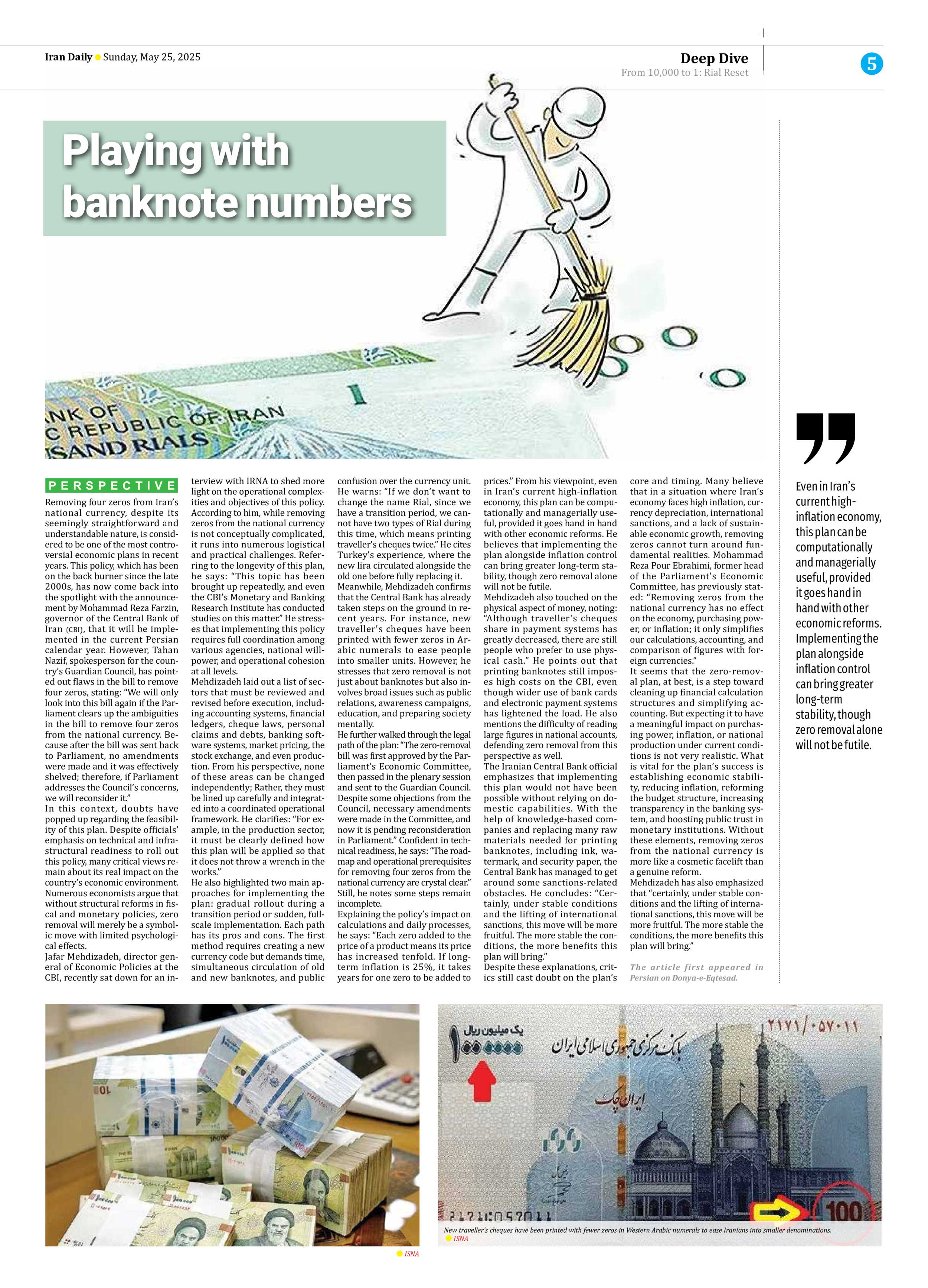
Playing with banknote numbers
Removing four zeros from Iran’s national currency, despite its seemingly straightforward and understandable nature, is considered to be one of the most controversial economic plans in recent years. This policy, which has been on the back burner since the late 2000s, has now come back into the spotlight with the announcement by Mohammad Reza Farzin, governor of the Central Bank of Iran (CBI), that it will be implemented in the current Persian calendar year. However, Tahan Nazif, spokesperson for the country’s Guardian Council, has pointed out flaws in the bill to remove four zeros, stating: “We will only look into this bill again if the Parliament clears up the ambiguities in the bill to remove four zeros from the national currency. Because after the bill was sent back to Parliament, no amendments were made and it was effectively shelved; therefore, if Parliament addresses the Council’s concerns, we will reconsider it.”
In this context, doubts have popped up regarding the feasibility of this plan. Despite officials’ emphasis on technical and infrastructural readiness to roll out this policy, many critical views remain about its real impact on the country’s economic environment. Numerous economists argue that without structural reforms in fiscal and monetary policies, zero removal will merely be a symbolic move with limited psychological effects.
Jafar Mehdizadeh, director general of Economic Policies at the CBI, recently sat down for an interview with IRNA to shed more light on the operational complexities and objectives of this policy. According to him, while removing zeros from the national currency is not conceptually complicated, it runs into numerous logistical and practical challenges. Referring to the longevity of this plan, he says: “This topic has been brought up repeatedly, and even the CBI’s Monetary and Banking Research Institute has conducted studies on this matter.” He stresses that implementing this policy requires full coordination among various agencies, national willpower, and operational cohesion at all levels.
Mehdizadeh laid out a list of sectors that must be reviewed and revised before execution, including accounting systems, financial ledgers, cheque laws, personal claims and debts, banking software systems, market pricing, the stock exchange, and even production. From his perspective, none of these areas can be changed independently; Rather, they must be lined up carefully and integrated into a coordinated operational framework. He clarifies: “For example, in the production sector, it must be clearly defined how this plan will be applied so that it does not throw a wrench in the works.”
He also highlighted two main approaches for implementing the plan: gradual rollout during a transition period or sudden, full-scale implementation. Each path has its pros and cons. The first method requires creating a new currency code but demands time, simultaneous circulation of old and new banknotes, and public confusion over the currency unit. He warns: “If we don’t want to change the name Rial, since we have a transition period, we cannot have two types of Rial during this time, which means printing traveller's cheques twice.” He cites Turkey’s experience, where the new lira circulated alongside the old one before fully replacing it.
Meanwhile, Mehdizadeh confirms that the Central Bank has already taken steps on the ground in recent years. For instance, new traveller's cheques have been printed with fewer zeros in Arabic numerals to ease people into smaller units. However, he stresses that zero removal is not just about banknotes but also involves broad issues such as public relations, awareness campaigns, education, and preparing society mentally.
He further walked through the legal path of the plan: “The zero-removal bill was first approved by the Parliament’s Economic Committee, then passed in the plenary session and sent to the Guardian Council. Despite some objections from the Council, necessary amendments were made in the Committee, and now it is pending reconsideration in Parliament.” Confident in technical readiness, he says: “The roadmap and operational prerequisites for removing four zeros from the national currency are crystal clear.” Still, he notes some steps remain incomplete.
Explaining the policy’s impact on calculations and daily processes, he says: “Each zero added to the price of a product means its price has increased tenfold. If long-term inflation is 25%, it takes years for one zero to be added to prices.” From his viewpoint, even in Iran’s current high-inflation economy, this plan can be computationally and managerially useful, provided it goes hand in hand with other economic reforms. He believes that implementing the plan alongside inflation control can bring greater long-term stability, though zero removal alone will not be futile.
Mehdizadeh also touched on the physical aspect of money, noting: “Although traveller's cheques share in payment systems has greatly decreased, there are still people who prefer to use physical cash.” He points out that printing banknotes still imposes high costs on the CBI, even though wider use of bank cards and electronic payment systems has lightened the load. He also mentions the difficulty of reading large figures in national accounts, defending zero removal from this perspective as well.
The Iranian Central Bank official emphasizes that implementing this plan would not have been possible without relying on domestic capabilities. With the help of knowledge-based companies and replacing many raw materials needed for printing banknotes, including ink, watermark, and security paper, the Central Bank has managed to get around some sanctions-related obstacles. He concludes: “Certainly, under stable conditions and the lifting of international sanctions, this move will be more fruitful. The more stable the conditions, the more benefits this plan will bring.”
Despite these explanations, critics still cast doubt on the plan’s core and timing. Many believe that in a situation where Iran’s economy faces high inflation, currency depreciation, international sanctions, and a lack of sustainable economic growth, removing zeros cannot turn around fundamental realities. Mohammad Reza Pour Ebrahimi, former head of the Parliament’s Economic Committee, has previously stated: “Removing zeros from the national currency has no effect on the economy, purchasing power, or inflation; it only simplifies our calculations, accounting, and comparison of figures with foreign currencies.”
It seems that the zero-removal plan, at best, is a step toward cleaning up financial calculation structures and simplifying accounting. But expecting it to have a meaningful impact on purchasing power, inflation, or national production under current conditions is not very realistic. What is vital for the plan’s success is establishing economic stability, reducing inflation, reforming the budget structure, increasing transparency in the banking system, and boosting public trust in monetary institutions. Without these elements, removing zeros from the national currency is more like a cosmetic facelift than a genuine reform.
Mehdizadeh has also emphasized that “certainly, under stable conditions and the lifting of international sanctions, this move will be more fruitful. The more stable the conditions, the more benefits this plan will bring.”
The article first appeared in
Persian on Donya-e-Eqtesad.







